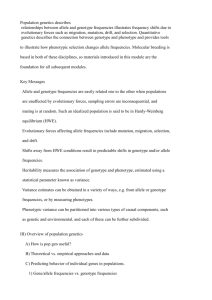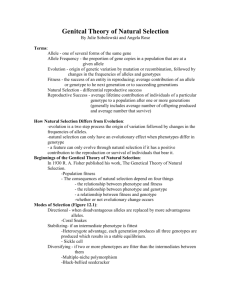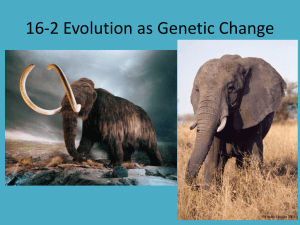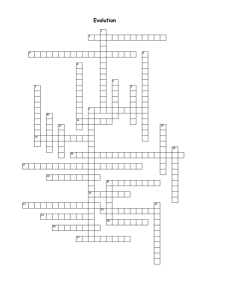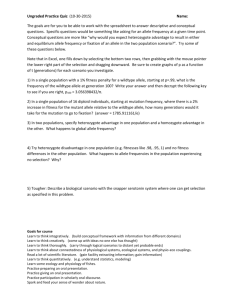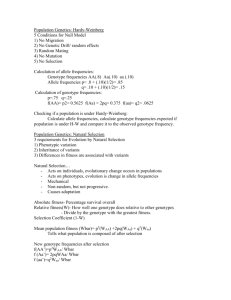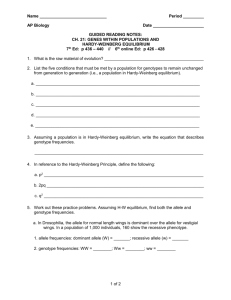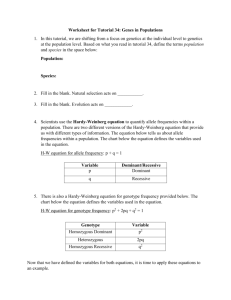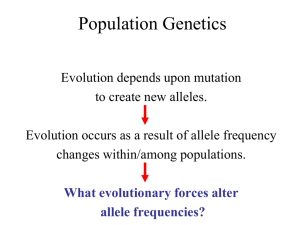Homework5_answers
advertisement
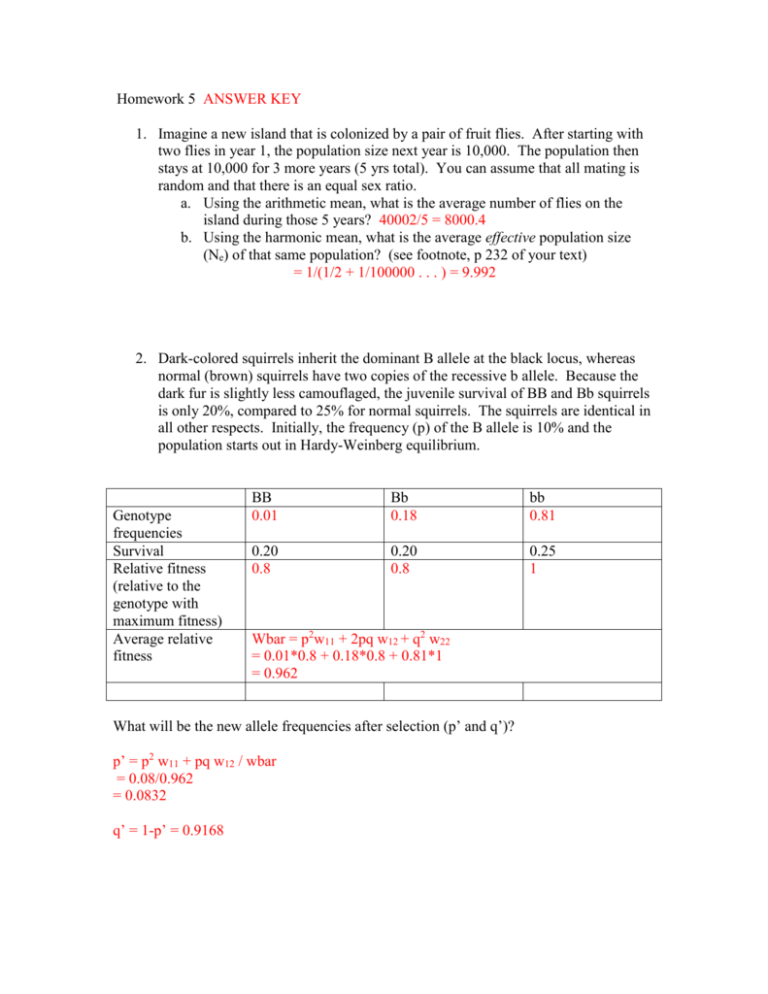
Homework 5 ANSWER KEY 1. Imagine a new island that is colonized by a pair of fruit flies. After starting with two flies in year 1, the population size next year is 10,000. The population then stays at 10,000 for 3 more years (5 yrs total). You can assume that all mating is random and that there is an equal sex ratio. a. Using the arithmetic mean, what is the average number of flies on the island during those 5 years? 40002/5 = 8000.4 b. Using the harmonic mean, what is the average effective population size (Ne) of that same population? (see footnote, p 232 of your text) = 1/(1/2 + 1/100000 . . . ) = 9.992 2. Dark-colored squirrels inherit the dominant B allele at the black locus, whereas normal (brown) squirrels have two copies of the recessive b allele. Because the dark fur is slightly less camouflaged, the juvenile survival of BB and Bb squirrels is only 20%, compared to 25% for normal squirrels. The squirrels are identical in all other respects. Initially, the frequency (p) of the B allele is 10% and the population starts out in Hardy-Weinberg equilibrium. Genotype frequencies Survival Relative fitness (relative to the genotype with maximum fitness) Average relative fitness BB 0.01 Bb 0.18 bb 0.81 0.20 0.8 0.20 0.8 0.25 1 Wbar = p2w11 + 2pq w12 + q2 w22 = 0.01*0.8 + 0.18*0.8 + 0.81*1 = 0.962 What will be the new allele frequencies after selection (p’ and q’)? p’ = p2 w11 + pq w12 / wbar = 0.08/0.962 = 0.0832 q’ = 1-p’ = 0.9168 3. A common phenomenon for plant and animal breeders is hybrid vigor, where hybrid individuals have higher growth and fecundity than homozygous pure lines. There is a lot of debate about whether that effect is caused by deleterious recessive alleles or true heterozygote advantage (see chapter 11). For this problem we’ll assume that it is due to heterozygote advantage at a single locus D. DD individuals produce 20 offspring on average; Dd individuals produce 22 offspring and dd indivudals produce 21 offspring. Assume the population starts with 100 DD, 100 Dd and 100 dd. (note that this population is NOT i n Hardy-Weinberg proportions, so you should use the observed genotype frequencies). BB Bb bb N 100 300 100 Starting Genotype 0.2 0.6 0.2 frequencies Absolute fitness 20 22 21 Relative fitness 0.9091 1 0.9545 (relative to the genotype with maximum fitness) Average relative Wbar = Dw11 + Hw12 + Rw22 fitness = 0.9727 What are the starting allele frequencies (p and q)? 0.5 and 0.5 What will be the new allele frequencies after selection (p’ and q’)? 0.4953 and 0.5047 4. A rare recessive genetic disease occurs at a frequency of 1/1000 births. The disease is always lethal. a. Assuming the disease is maintained by mutation-selection balance, what is the approximate mutation rate for the disease allele? q2=0.001 = u/s. s=1 (because lethal). Therefore, the mutation rate must be 0.001 b. Based on the mutation rate from part a, is it reasonable for this disease to be maintained by mutation-selection balance? Probably not, because a mutation rate of 10-3 is much too high (normal mutation rates are about 10-6). (It is possible that some loci with simple sequence repeats could have muation rates almost that high, however.) Other explanations: there could be a very slight heterozygote advantage. Or, if population size is small, the locus could have drifted to higher frequency than predicted by mutation-selection balance. 5. An animal breeder is breeding for long hair in hamsters. She does this by choosing some of the hamsters with the longest hair in the population and using them as breeding stock. Here are the results of the first breeding experiment: Average hair length in existing population 5 mm. Average hair length of hamsters selected for breeding 8 mm. Average hair length of offspring of the selected hamsters: 6 mm. a. Calculate the selection differential, response to selection, and heritability (h2) for hair length. Use the relationship R=h2S. The response is the change in mean across generations, = 1 mm increase. S is the difference in mean of the selected parents compared to the whole population = 3 mm. Therefore, h2 must be R/S = 0.333. 6. The slope of the regression of offspring beak depth on mid-parent beak depth in Galapagos finches is 0.8. You measure 100 randomly chosen birds on the island Daphne and find that the average beak depth is 9 mm and the variance in beak depth is 70 mm2. b. What is the additive genetic variance for beak depth in this population? Use the relationship h2=Va/Vp. The P-O regression gives you the heritability. Vp (phenotypic variance) is 70 mm2 and h2 = 0.8, so Va=56 mm2.


